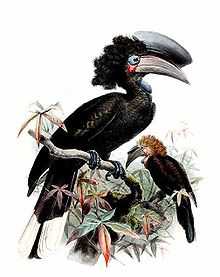Ceratogymna
From Wikipedia, the free encyclopedia
| Ceratogymna | |
|---|---|
 | |
| Ceratogymna atrata | |
| Scientific classification | |
| Kingdom: | Animalia |
| Phylum: | Chordata |
| Class: | Aves |
| Order: | Coraciiformes |
| Family: | Bucerotidae |
| Genus: | Ceratogymna Bonaparte, 1854 |
| Species | |
|
2, see text. | |
Ceratogymna is a genus of large, primarily frugivorous hornbills (family Bucerotidae) found in the humid forests of Central and West Africa. They are sexually dimorphic, with males being overall black, while females have brown heads and a smaller casque.[1] Unlike the members of the genus Bycanistes, the two species in the genus Ceratogymna have extensive, primarily blue, bare facial skin and dewlap, and the only white in their plumage is in the tail (although the Yellow-casqued Wattled Hornbill also has slight whitish speckling on the neck).
Species
- Black-casqued Wattled Hornbill (Ceratogymna atrata).
- Yellow-casqued Wattled Hornbill (Ceratogymna elata).
The members of the genus Bycanistes have been included in this genus, but today most authorities consider the two separate.[1]
References
- ↑ 1.0 1.1 Kemp, A. C. (2001). Family Bucerotidae (Hornbills). Pp. 436-523 in: del Hoyo, J., Elliott, A., & Sargatal, J. eds. (2001). Handbook of the Birds of the World. Vol. 6. Mousebirds to Hornbills. Lynx Edicions, Barcelona. ISBN 84-87334-30-X
This article is issued from Wikipedia. The text is available under the Creative Commons Attribution/Share Alike; additional terms may apply for the media files.